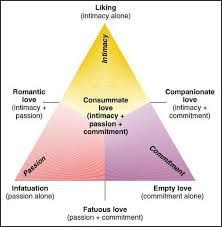How the Triangular Theory of Love Can Lead to Fulfilling Intimate Connections and Relationships7/23/2021 Author: Alejandra Hilbert  Psychologist Robert Sternberg proposed that there are three different building blocks which combine to form different types of love. These components are intimacy, passion, and commitment. Intimacy is defined as feelings of warmth, understanding, trust, support, and sharing. Passion is characterized by physical arousal and desire, excitement, and need. Finally, commitment is typified by feelings of permanence, stability, and the decisions to devote oneself to a relationship and to work to maintain it. Under Sternberg’s model, there are eight relationship types (as illustrated here). Utilizing Sternberg’s conceptualization of romantic partnerships, one can compare a romantic relationship to a stool. A stool only propped up by one leg is much less likely to support one’s weight, whereas a three legged stool could unwaveringly; thus, relationships with two or more of the critical components will lead to a greater sense of fulfillment, dependence, and security. Utilizing the stool metaphor, single leg relationships are those with only one building block. An example of this relationship structure is empty love, which describes a relationship where commitment is high, but there is little intimacy or passion—in essence, a work relationship. Conversely, a relationship which is high in passion but lacks intimacy and commitment is infatuation, or colloquially known as a crush. Intimacy, passion, and commitment are all absent in nonlove. Ideally, a strong dose of all three components should exist within the partnership, as typified by consummate love. Throughout the course of the relationship, there will likely be a shift in prevalence of particular blocks and how they appear. Passion may run high in the beginning of a new romantic relationship, as coined by the term new relationship energy (NRE). Sheer novelty adds excitement and energy to new loves. Once a relationship is established and novelty is lost, passion slowly subsides; typically the longer a relationship lasts, the less passionate it becomes. However, other components, like intimacy and commitment, are bolstered to maintain balance. Time alone does not cause intimacy, passion, and commitment to occur and grow, but rather deliberate effort is needed to foster these critical components if they do not initially exist in your partnership. Knowledge of this model of love may help couples avoid pitfalls in their relationship, allow for intentional work in areas that need improvement, or aid partnerships recognize when it may be time for a relationship to end. Sternberg asserts that reaching consummate love is often easier than maintaining it. Understanding that there is an ebb and flow in which building blocks may appear in our relationships, have are few recommendations on how to cultivate continuous consummate love:
Sources
0 Comments
Your comment will be posted after it is approved.
Leave a Reply. |
Archives
October 2021
Categories |
- Home
- For Clients
-
For Professionals
- All Trainings
- On Demand Workshops
- Attachment Based - CBST Yearlong
- Summer Intensive
- One Way Mirror Training
- Consultation Groups
- CBT Training
- EFT Couples Training
- Family Therapy Training
- ESSFT Certification
- EMDR Training
- Child Therapy
- Motivational Interviewing
- ADHD Treatment
- Seeing the Blind Spots: A Consultation Group for Examining White Therapists' Privilege
- Seeing the Blind Spots: Exploring How You Think About and Experience Gender Diversity
- Supervision, Law, and Ethics
- Telehealth Workshop
- DBT for Alcohol and Drug Addiction
- Strength Based Culturally Informed Integrative Therapy
- About
- Contact



 RSS Feed
RSS Feed